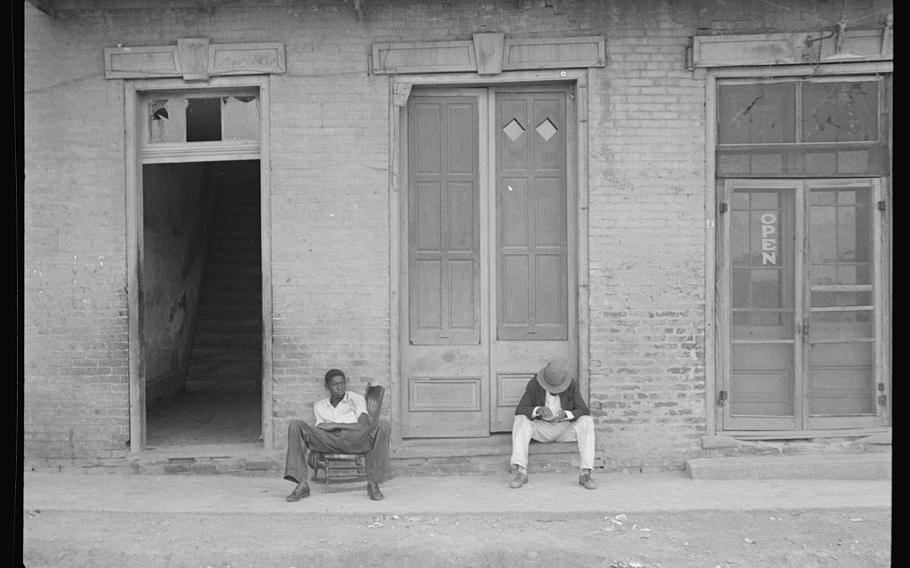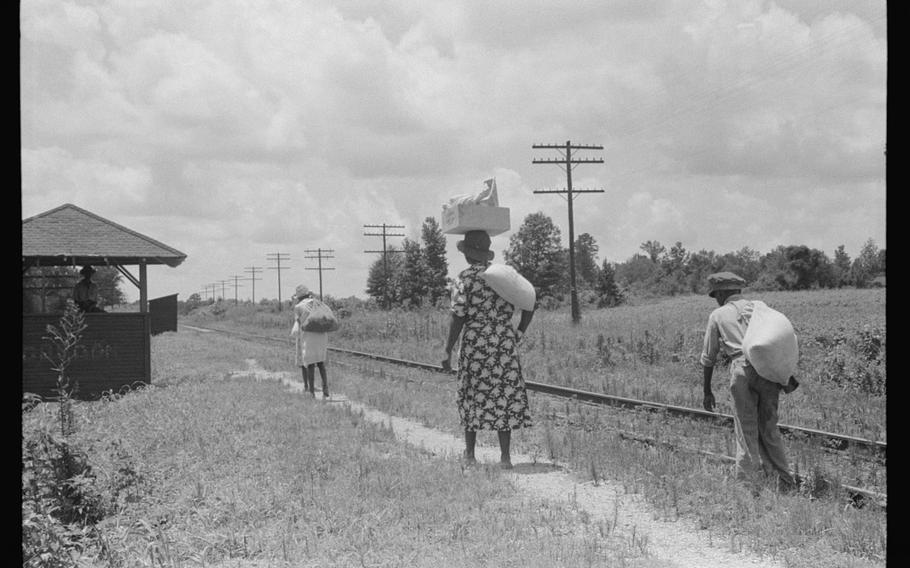
Black residents of Natchez, Miss., sit outside a building in 1935. (Ben Shahn/Library of Congress)
Natchez was the largest slave-trading market in Mississippi before the Civil War, and one of the largest in the country. Today, the city is full of the former homes of plantation owners and their slave quarters, though for many years, these sites didn’t acknowledge their Black history publicly.
One of those former slave quarters sits on an estate that housed 124 enslaved people in 1844. In 2014, Debbie Cosey, now 66, and her husband, Gregory, now 72, bought the building. It was in significant disrepair, with dirt floors and plants growing out of the walls. Over 2½ years, the couple renovated it, converting it into a bed-and-breakfast called Concord Quarters. Now they live on the first floor, and the second floor accommodates six guests.
Cosey and her husband are Black, both descended from enslaved people. And rather than conceal their home’s troubled history, they’re doing all they can to share it with their guests.
Natchez, like many Southern locales, has a long history of downplaying its role in slavery. But in recent years, especially since the 2020 racial justice protests, there have been renewed efforts across the country to tell the whole truth about the antebellum period. Activists have pressured plantations not to gloss over slavery on their tours, and many sites, including some in Natchez, have become more open about their history of slavery.
Cosey wants to highlight the stories of the enslaved people who toiled at the Concord estate. Aside from a small, deteriorated building of unknown use, Concord Quarters is all that remains of the original estate. The main house was built for Spanish Governor Manuel Gayoso de Lemos in 1794-95, when the territory was under Spanish control, and after being sold more than once, it burned down in 1901, according to Historic Natchez Foundation.
In 2019, Concord Quarters was listed on the National Register of Historic Places. Last year, Mississippi State University led an archaeological dig on the property, which unearthed numerous artifacts, some of which are on display for Concord’s guests, including a brick with the fingerprint of an enslaved person.
Historic homes in Natchez have long struggled to talk about slavery, said Cosey. Years ago, she said, she was working for a historic inn in town, and she was asked not to broach the subject. “They said to me, ‘You stick to the script, Debbie,’” she said. (The inn did not respond to requests for comment.)
But at Concord, “I wrote my own script,” she said. “Perhaps I will talk about slavery, and if that offends you, I won’t be offended if you leave.”
She added, “Why not talk about it? Why not give honor to those people that your ancestors enslaved? Is it that hurtful to you? Are you that embarrassed? And if you are, if you talk about it, I feel it’s good healing for your soul.”

Black residents of Natchez, Miss., walk alongside a railroad track in August 1940. (Marion Post Wolcott/Library of Congress)
Joseph McGill, a history consultant at Magnolia Plantation & Gardens in Charleston, S.C., stayed at Concord in 2018 as part of his Slave Dwelling Project, through which he educates the public on slavery by giving talks and spending the night in former slave dwellings. He travels widely for the project, and Natchez was high on his list of places to visit. For many years, when visiting antebellum sites in Natchez, “you heard about the architecturally significant big houses, the nice beautiful grand staircase, the place settings, vaulted ceilings, drapes, and things of this nature,” said McGill. “But very seldom would they talk about whose labor was stolen to make all that happen.”
McGill said of the local tourism industry, “They take pride in benefiting from the ‘Gone With the Wind,’ hoop skirt, mint julep-type story. They’ve been making money handsomely off of that story.” Tourism is the largest industry in Natchez, which is 62 percent Black as of the 2020 census; Mississippi River cruises are a major draw.
Some of the historical sites in Natchez are now discussing slavery more openly. In 2021, the Historic Natchez Foundation started installing permanent slavery exhibits in historic homes that offer daily tours. Three exhibits are complete, and two are still in progress. The artifacts on display include maps, a historic image of a house, and a page from a slave schedule that lists ages, sexes and sometimes names of enslaved people. At a home called Longwood, there’s a rare portrait that was painted of a man while he was enslaved.
These exhibits first appeared on the homes’ porches during the early part of the COVID-19 pandemic as an outdoor attraction for visitors. But even before COVID and the 2020 racial justice protests, historical site operators in Natchez were asking for help educating visitors on slavery, said Carter Burns, executive director of the Historic Natchez Foundation. “The public expects to hear those stories,” he said.
In 2021, Natchez donated the site of its former slave market to the National Park Service. The site, called Forks of the Road, is part of Natchez National Historical Park. The city is working on a Forks to Freedom Corridor, a trail to teach visitors about slavery and other Natchez Black history, but funding has not yet been secured, said Natchez Mayor Dan Gibson. “We recognize we have a difficult past, as so many cities in the South do,” he said. “But we also recognize that we’re making tremendous progress.”
Many visitors have expressed their support for the city’s new emphasis on the lives of enslaved people, but there has been some dissent, said Roscoe Barnes III, cultural heritage tourism manager for Visit Natchez. One commenter on Instagram suggested that telling these stories would hurt tourism, said Barnes. “He believed that we should go on telling the stories about the antebellum period and the homes, and call the enslaved ‘servants’ and basically whitewash the history,” Barnes said.
Rural plantations are obvious targets for inclusive storytelling, but there hasn’t been as much scrutiny on urban and suburban historical homes that held enslaved people for domestic work, like the ones in Natchez. During slavery, Natchez’s town center was surrounded by a ring of suburban villas, said Burns. The residents of those villas didn’t grow crops there, but rather on plantations farther outside town or across the Mississippi River in Louisiana.
There have also been calls for plantations to stop hosting weddings, a practice that many deem disrespectful to the human lives lost in these places. Concord Quarters is an unusual example of a Black-owned slavery-related site that hosts weddings.
Cosey didn’t originally intend to open a bed-and-breakfast, she said, but was attracted to Concord as a potential wedding venue, especially given its majestic columns, popular among brides in the area. She counsels couples on the property’s history of slavery and asks how their guests may feel about it. “I see things differently because I am a Black woman who owns a slave dwelling,” she said. “I convey things differently.” She added, “These were our people who were enslaved.”
McGill has long opposed plantation weddings, but he acknowledges that for many of these historical sites, weddings are a crucial source of revenue. “If these organizations are going to have these weddings, they should tie them into reparations,” he said, perhaps by charging a fee that funds a scholarship program for the descendants of enslaved people.
While activists try to amplify these historical Black voices, Black history curriculum has been rolled back at many schools across the country, particularly in the South and other Republican-leaning areas. Some parents are now looking to museums and other institutions outside of schools to educate their children about this history. Historical sites “should step up and be the place that you can still go to get this history,” McGill said.
After all these years, Natchez is becoming a place to learn about Black history. “That nut has finally been cracked,” McGill said.